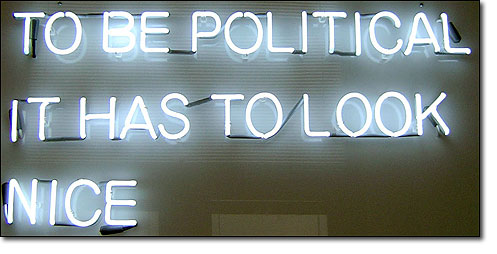Apexart,
Oct 11, 2003 - Nov 08, 2003
New York, NY, USA
To Be Political it has to Look Nice
by Raúl Zamudio
Theodor Adorno once wrote that an effect of capitalism’s conversion of art into an industry was the museum’s transformation into a mausoleum; that museums consequently became the sepulchers of art. But Adorno’s observation of the power of capitalism’s tendency to subsume should not have only been targeted at the Right. For some artists on the Left who become overeager to be political unwittingly end up appearing like ideologues in transgressing ethics in their practice, and consequently play into the hands of what they are contesting (remember Hannah Wilke’s 1974-77 piece that responded to conservative feminism with the text, "Beware of Fascist Feminism"?). It’s not that one should cease making political art or that politics and art shouldn’t mix, because they always do whether through the front door or the backdoor. But when political art announces itself as such, how far is it from didacticism and soap-boxing when subtly is completely discarded? The best political art blindsides one with its politics and does not jettison aesthetics or poetics for content, and in fact may ostensibly be devoid of political themes altogether. On the other hand when art veers into pure propaganda an interesting thing occurs: and that is that art is exposed as ideologically inflected. Walter Benjamin succinctly alluded to this at the end of his famous "Mechanical Reproduction" essay. Apropos Adorno’s statement about capitalism and the culture industry, Benjamin noted that one of the strategies of the modernist nation state is to infuse the aesthetic into politics thus making ideology palatable; and Benjamin’s response to this is that one should do the inverse and politicize art. The most astute art with a political edge, however, is the kind that gets under one’s skin and festers in one’s unconscious subsequently attaining a certain critical valence. Unfortunately the recent Apex Art exhibition, To Be Political It Has To Look Nice, lacked critical savvy to achieve this and this may have been because of its curatorial opacity. To Be Political It Has To Look Nice’s curatorial framework was about "an investigation of the projects and a presentation of cultural articulations of the aesthetical, the political, the social and the everydayness taking place in, or manifesting its origins from the American sub-continent." This opaque and broad parameter was countered with a clarification that the show claimed not to be a survey, though the above statement sure made it sound like one. And while the curatorial subtext says a lot about placing one’s cards on the table, To Be Political It Has To Look Nice was neither like the Whitney’s American Effect nor was it tightly framed like Unpacking Europe. And the only reason why I am stating these comparisons is because the curatorial directive went on with digressions about identity, stereotypes and problematic constructs about the ideologically charged nomenclature surrounding the geo-cultural region known as Latin America. In one sense, then, the Apex show focused on what constitutes this rubric, though it could have been more self-reflexive in interrogating notions from the inside about this homogeneous and monolithic continental descriptive. For subjectivity, identity and nationalism as well is never a one-way street but are constituted from dialogical interactions whether they overt of covert, and from both the inside and the outside.
|













